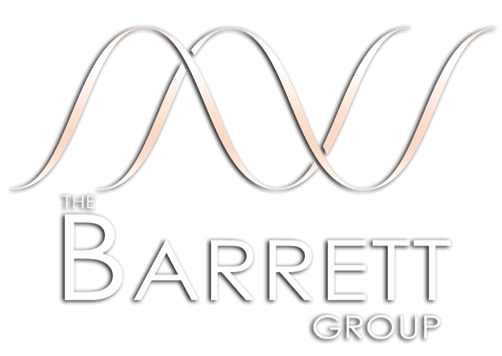Trends in Employee Benefits and Perks: How Important Are They to Your Overall Compensation Package?
by Julie Norwell
Employee benefits and perks have come a long way since the advent of company cars and casual Fridays. A review of emerging benefits and perks in today’s business world yields novelties. Such as “pet leave” for new pet owners, nap pods for sleeping breaks, and beer on tap. These kinds of offerings are certainly a testament to what appeals to millennial workers. They comprise an increasingly large share of the labor force. But it’s not just millennials who are driving this demand.

The volume and diversity of benefits and perks now available to workers at companies bespeaks the growing value that employees place on them in the workplace – a value that sometimes rivals hard cash. According to a 2015 survey by company review website, Glassdoor, nearly 80% of employees would prefer new or additional job benefits to a pay raise. They also play a significant role in the job search process. Three in five people report that benefits and perks are among their top considerations in accepting a new job.
In an employment market as tight as the current one, employers need to pay attention. Because those who don’t risk squandering an opportunity to attract the best talent.
FAMILY AND FLEXIBILITY
In 2015 Netflix made headlines by offering unlimited parental leave – to both moms and dads –in the first year after the birth or adoption of a baby. That offer was in addition to its unlimited time-off policy for vacation and sick leave.
Netflix is an outlier when it comes to such generous benefits, but many companies are, nevertheless, trending towards more family friendly and flexible leave offerings. According to the 2019 Employee Benefits Report of the Society of Human Resource Management (SHRM), which surveys employers annually about their employee benefits offerings, more than one in three U.S. employers offer paid maternity leave. Up from 21% in 2015, and many of them offer more leave than the federal and state mandates. In the same time frame, the number of companies offering paternity leave (30%) has almost doubled. Nursing moms will be happy to learn that this year more than half of U.S. employers report offering lactation rooms. This compares to just 35% in 2015.
Employers are ever more responsive to the high demand for flexibility in work schedules and remote working. With nearly 60% offering flextime during core business hours and almost 70% offering occasional telecommuting, up from 56% in 2015. In fact, more than one-quarter of respondents allow their employees to telecommute full-time.
FASTEST GROWING BENEFITS AND PERKS
The greatest increase in benefits were concentrated in health-related and wellness categories. 20% of employers indicating they had increased offerings in those areas. Given the prominent role many employers play in providing health insurance to employees, they have a great incentive in keeping healthcare costs down. And increasingly ply their workforce with wellness tips and information. About one-third have consistently offered an onsite fitness center, fitness classes, or memberships to fitness centers for the last several years. And just as many are offering a health insurance premium discount for participating in a wellness program, up from 17% two years ago. Nearly 40% offer company-organized fitness challenges.

Other notable changes in benefits and perks offered this year include the rise in onsite stress management programs, company-paid snacks, employee referral bonuses, and the number of employers who allow pets at work. And the number of companies offering standing desks have jumped from just 25% in 2015 to a whopping 60% this year.
Employers seem increasingly willing to invest in their employee. Over half of employers offer tuition assistance, and the ratio of companies offering student loan repayment, while still small, has doubled since 2015. In addition to professional development opportunities, which most companies have offered for years, an increasing number of employers are offering formal mentoring programs. And executive or leadership coaching, which didn’t even make the list five years ago, is now offered by four out of ten employers.
BENEFITS THEN AND NOW
Not surprisingly, the most commonly offered employee benefits are health insurance, life insurance, disability insurance, retirement benefits, and paid leave for vacation and illness. The roots of these old standbys date to the 1940s. When companies were precluded by the Stabilization Act of 1942 from raising wages (in an effort by the U.S. government to prevent wartime inflation). Unable to compete with high wages for workers, companies began offering health insurance and other non-income benefits as part of their overall compensation package.
Today, nearly all companies offer these basic benefits in some capacity to their employees and have continued to add more. Over the 20th century the composition of benefits in employers’ total compensation costs has continued a steady rise. They now comprise about 30% in 2019, according to the Bureau of Labor Statistics.
What’s really interesting, however, is how much the variety and volume of benefits and perks have exploded in recent years. Twenty years ago, the SHRM tracked 60 employee benefits. In this year’s annual report, by contrast, that number has ballooned to 350 – and it’s likely to continue growing, according to SHRM.
Why? One reason is that benefits enhance a company’s appeal to workers without necessarily driving up fixed costs, as higher wages and salaries do. Another reason is that in our increasingly stressful world, workers are putting greater value on things beyond money. After all, how do you put a price tag on a flexible schedule, an in-house mentoring program, or the freedom to bring your dog to the office?

GET THE COMPENSATION YOU WANT
The growing importance of benefits and perks to workers notwithstanding, the negotiation of any new job, naturally, starts with salary. The first step in the process is to know what you’re worth. There are many online tools to estimate the salaries of particular roles in particular industries. Some are even able to calculate personal factors that could influence the estimate one way or the other. The second step is to do your research. Know what companies are paying for similar jobs in different industries, and how things may vary based on geography.

When a job offer comes and it times to discuss compensation, don’t be afraid to negotiate. And if you’re like many workers in the job market today, you won’t limit yourself to discussing money.
The benefits and perks offered by a company shape its culture and values, which may translate into greater job satisfaction. Smart employers who don’t leverage these to get you in the door will lose out on attracting top talent.
More articles by The Barrett Group Legal:
Exciting Developments
We are using this blog to share the experiences of our clients as they embark on their career change journeys. Let’s face it: changing jobs can be daunting or downright scary. That’s why we share. To let you know you are not alone and there is light at the end of the tunnel. Exciting Developments!
Let’s talk about a recent client named Harry.
We first spoke to Harry in January. At the time he was still busy in his own company. But by May he was past that and focused on his career search. Harry was 65 years old at the time, and wanted to work for 5 more years, at which time his son will likely have graduated college. Harry had run his own construction management company for the last 3 years but he was winding things down and finishing up last projects. He and his wife also have a medical billing franchise, however, in the meantime she can run this without him.

Harry had found searching online, and trying to contact recruiters very discouraging, and was looking for a more effective search strategy. His wife was very supportive, too, to the point where she was willing to sacrifice and move to New Jersey if necessary, even though she really preferred Florida.
The Barrett Group (TBG) program kicks off with a Targeting component (our Clarity Program©), then the Packaging, Market Access, Preparation, and On-Boarding stages guide the client to their ultimate success.
During our Clarity Program© Harry came across as a high Dominance, driven personality, who nevertheless demonstrated a coolheaded reserve and reflection under stress. The psychometric element also highlighted a few areas of potential improvement.
For example, Harry had a tendency to
- Take on too much, too soon, too fast.
- Blame, deny and defend his position–even if it is not needed.
- Be disruptive because of his innate restlessness and disdain for sameness.
Indeed, often our clients get in their own way during the career change process, but Harry was open-minded and accepted the need for change in certain of his behavior to his own advantage.
The Clarity Program© also helped him formulate a crisp career target: Senior Vice President of Construction at a significant real estate development firm.
Harry stayed with the TBG program despite his innate restlessness, working through the Packaging, Market Access, and Preparation stages. He embraced the TBG method regarding expanding his social networking efforts (as part of the Market Access phase) and one of his construction contacts introduced him to the VP of Construction as a target company.
That VP, however, was traveling a lot and Harry became panicked when the VP became non-responsive after a few weeks. We helped him stay calm and focused and finally the VP set a meeting with Harry. So we coached him through it. The VP was so impressed that he arranged a direct meeting with the CEO—a great meeting in which the CEO asked Harry to write a white paper laying out changes in the company Harry could implement.
We provided a line by line review of the white paper. The CEO was very impressed by the final white paper, and that, naturally, resulted in an initial job offer. Our clients enjoy support from a six-person team, all of whom got involved in the negotiation brain-storming because there was a lot of room to negotiate. The final offer came in at a total comp of $1.3 million.
Harry landed his new job in less than 90 days, too.
We wish we could achieve such results every day, but, whatever your targets, we can certainly help you reach them faster and more effectively if you follow our process and are willing to work.
Peter Irish
CEO
The Barrett Group
Suddenly Unemployed and in Shock
In these blogs we like to explore situations that can happen to our readers, such as becoming unemployed, in which the Barrett Group (TBG) can really help alleviate job search stress.
Let’s talk about Dominic.
Here’s what our Senior Career Consultant had to say about Dominic in March at the beginning of our engagement:
Dominic just lost his job on Friday so he has a high sense of urgency to get things moving. He has both an MBA and Doctorate as well as speaking 3 languages. Originally from France. He loves to talk but in a nice way. I know that the Clarity Program© will be a tremendous help to him. He wants to move to our full program next week if possible.
How can we help him? He has no idea of how to market himself at a high level. He talks a lot but his approach is scattered. Not sure at all what is possible with his background. Our systems and strategies can make a huge difference in his career.
Very sincere gentleman who needs our help. Our initial discussion lasted over an hour. He loves to talk. He definitely has talent but needs structure big time. Needs to stay in Indianapolis due to wife’s job with which she has had for a long time.

One aspect of our process that clearly sets us apart is that at the Barrett Group we like to explore our clients’ objectives much more deeply via our Clarity Program© because we look at the whole person when clarifying career objectives—not just the targeted title, compensation, and geography—regardless if they are executives, lawyers, people transitioning out of the military, or other professionals seeking support.
During the Clarity Program© we discovered that Dominic, like many of our clients, is a high I (Influencing) and high D (Dominance) with relatively low S (Steadiness) and C (Compliance) dimensions in his natural DISC style. That means, of course, that he is highly extroverted—hence the “talks a lot”—and that he is not very self-reflective or analytical. Helping him recognize these tendencies was key to helping him succeed.
Dominic also emphasized improving Financial Independence and Business Success as the most important elements in his short term objectives.
His Vision (part of his Personal Strategic Plan) included these comments: “I work for a global organization that appreciates my multi-lingual and international capabilities and values me as a unique employee. I live in the Indianapolis area. My annual compensation is $150k, with 401(k). I am in a leadership role.” This is a simple and clear Vision that proved to be highly attainable.
At the Barrett Group we follow a process that begins with Targeting (the Clarity Program©), then moves into Packaging (resume versions plus LinkedIn), then Market Access (here’s where we open up three main markets including the Unpublished Market where fully 75% of our clients land), Preparation (interviewing and compensation negotiation), and On-Boarding.
Our clients are supported by a six-member team including a Clarity Coach, a Career Consultant, a Writer, a Researcher, a Negotiation Coach, and a Client Concierge, so, while it is critical that clients be willing to do the necessary work, they never have to do it all by themselves.
Dominic stared with us in March of 2019. Slightly less than six months later, Dominic wrote to his TBG Career Consultant:
“I was surprised with a letter of offer. While salary was never discussed ever in the 5 interviews that I had with [new employer]. It was a firm and straight forward offer and it was acceptable to me. I accepted that offer officially! My start date will be 9/23.”
We still ring a bell when a client lands, and these days it is sometimes hard to get any work done with all of those bells ringing.
Peter Irish
CEO
The Barrett Group
Are You Tinkering With Your Career or Engineering Success?
This blog is intended to help our readers understand the variety of professionals who come to the Barrett Group with their career in disarray and how we help them find relief, confidence, and, above all, success in achieving their professional aspirations.
Nothing convinces, they say, like success so let’s talk about Frank, age 61, high powered training systems architect for a major aerospace conglomerate—1 out of only 3 who can do his job in the entire company. But Frank felt his career had plateaued and desperately wanted to leave the company because they were not flexible. His location requirements were very specific.
He wanted to move to Northern Alabama so he could be with the kids. His wife Sheila was in on every single interview, so she has been a big part of the decision-making process.

Frank knew there is no future with his current employer. He had been making about $180K but would be happy with six figures to do something he loves in the right location. He felt a strong sense of urgency, too because he had been searching online for three years with no results. Frank has come to believe that the internet has become a millennial channel.
Frank signed on with the Barrett Group (TBG) mainly because he felt that after 3 years of searching on his own he really needed professional help to make a proper transition. We believed that he would be an excellent client, too, (one willing to do the necessary work to succeed) partly because of his wife’s attentive support.
Let’s flash forward now, to how he felt four months later when he signed on with his new employer…
“So, here I am, in a hotel room in Philadelphia, PA where I had this last interview only about 2 hours ago. It could not have gone better
. Simply put, at the 18-minute mark, [my future boss] said, ‘…I cannot think of another thing to ask you. This is just a formality. I think you are going to be a great asset to this team.’
“I want to go outside and jump for joy at the moment. But I will contain myself.”
How did we accomplish this success?
It is the patient application of our tried and true process beginning with the Targeting component (our Clarity Program©), then the Packaging, Market Access, Preparation, and On-Boarding stages that brought home the bacon.
One aspect of this process that clearly sets us apart is that at the Barrett Group we like to explore our clients’ objectives much more deeply via our Clarity Program© because we look at the whole person when clarifying career objectives—not just the targeted title, compensation, and geography—regardless if they are executives, lawyers, people transitioning out of the military, or other professionals seeking support.
If you are just tinkering with your career and getting nowhere, try reengineering it instead and seek the professional support your career deserves, for example, from the Barrett Group.
Peter Irish
CEO
The Barrett Group
Doctoring Your Career
Doctoring your career. Today I want to return to telling you about real people who have overcome their challenges and landed great jobs through their own efforts. (With excellent advice and support from the Barrett Group.)
Edgar is an Orthopedic Surgeon with a double masters, MBA and MSHA. After running the Orthopedic Surgery Department for a state VA, he focused his career on the medical administrative side taking a variety of Medical Director and CMO positions in a number of hospitals. He recently left such a role in March 2019. During our initial conversations he said his objective was to land in another Medical Director opportunity.
However, at the Barrett Group we like to explore our clients’ objectives much more deeply via our Clarity Program© because we look at the whole person when clarifying career objectives—not just the targeted title, compensation, and geography—regardless if they are executives, lawyers, people transitioning out of the military, or other professionals seeking support.

So, it soon became clear that Edgar really didn’t want just another CMO or Medical Director role. His real objective is to leverage his medical experience in an environment looking to improve and impact the delivery and quality of medical services.
He has tried to make such an impact in the hospitals and clinics where he has worked only to be shut down from a higher level. He has thought about think tanks and nonprofit organizations like WHO, UN, World Bank. He also had a real interest in start-ups companies involved within this same arena.
When we started, Edgar was at a loss as to how to achieve his career goal—how to change the focus of his career. He has always been in a clinical environment and laments that he has never had any “career smarts”.
Edgar felt he has been floundering in the weeds, playing in the wrong space and he wants to finally get to the right environment but doesn’t know how to get there. He was looking for help in identifying and breaking through to the right level in health care industry jobs.
Edgar is also a workaholic.
His idea of balance is to work non-stop. He can appear somewhat idealistic but has made some strides in changing the delivery of medical services in the past. He really needed information and guidance to achieve his goal and he is well aware of that need.
His Clarity Program© bore all of this out, of course, because he is a High-I (Influencer) from a DISC point of view but also above the water mark of Compliance and Steadiness. We helped him weed through his garden of professional desires, narrow his focus, and come out with a much clearer, if aspirational, set of career objectives.
Then we helped him pursue it through the Packaging, Market Access, Preparation and On-Boarding stages of our Career Management Program.
Edgar started with the Barrett Group on April 18, 2019 and wrote to his career consultant on August 5th:
“Meanwhile, [the future employer] made me my asking demand finally at 5:45 pm on Friday. Once again, you and Dan were right.” (Dan Resendes is our Chief Consulting Officer.)
Edgar would certainly agree with another Barrett Group medical client, Dr. Gary McCarragher:
“…the team rapidly succeeded in realizing my dream for fulfilling career change as a hospice physician and college professor in the biological sciences. I applaud the Barrett Group’s compassion, work ethic, and above all, their commitment to RESULTS. Kudos to the Barrett Group!!”

In fact, we work a bit like a doctor, collecting the symptoms of dysfunction and dissatisfaction as our clients reveal them, developing a hypothesis, and then delivering a diagnosis in the form of a Career Change Program.
How is your career health? Maybe it could benefit from some professional attention.
Peter Irish
CEO
The Barrett Group
Meeting our Clients’ Great Expectations
As I’ve mentioned before, literally thousands of executives come to us each year with expectations of how we can help them in their career development. Some of them have very specific needs and expectations (such as demonstrating transferability of skills across industries) while others simply realize that they might be great surgeons, lawyers, engineers, or other expert professionals, but in the business of finding that next better, more satisfying, and more lucrative job… they need help.
So, statistically, why do executives come to us?
Our clients’ expectations. We’ve done a little digging and, in the hopes that you might see some commonality in your own needs, we would like to share some of these insights here.
First, there is a definite bias in our sample toward higher salaries. For example, while 55% of those who contact us claim to have earned $100,000 or more in their most recent job, this number swells to over 85% amount those who actually become clients.
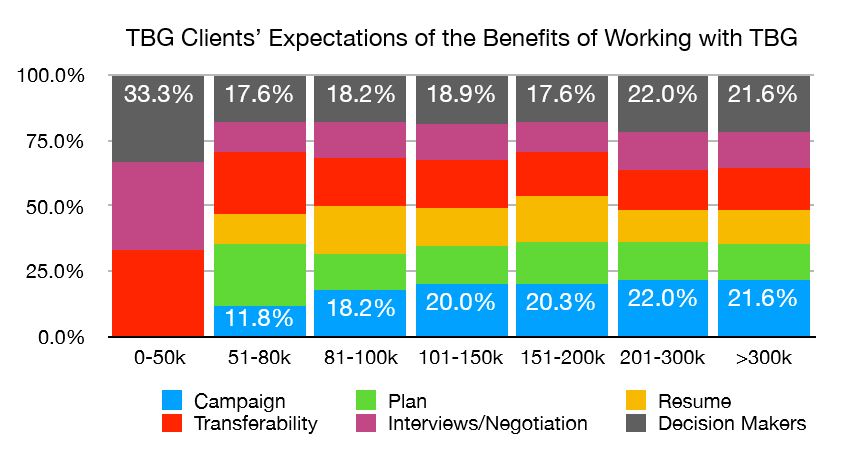
This bias plays out at the specific expectation level, too. However, let’s look at the universe of those who contact us first.
In a sample of almost 6,000 prospects, the distribution of how they expected the Barrett Group to be able to help them was surprisingly uniform:
- 18.8% Effective Job Campaign
- 16.3% Professional Career Plan
- 15.8% Superb Communication of my Resume
- 17.8% Demonstrating Transferability of Skills
- 14.2% Support in Interviewing and Negotiating
- 17% Facilitating Access to Decision Makers
Among clients, however, there was a stronger clustering on the Effective Job Campaign and the Facilitating Access to Decision Makers expectations, both coming in at about one-fifth. The uniformity holds up across all income categories for prospects, too, with only a slight trends toward Facilitating Access to Decision Makers as well as Effective Job Campaign and away from Support in Interviewing and Negotiating as income increases.
This trend is however far more pronounced among actual clients among whom the Facilitating Access to Decision Makers and Effective Job Campaign expectations together swell to about 44% vs. 39% among prospects.
As I’ve mentioned before, our Targeting Process, the Clarity Program©, is one reason we are so successful in fulfilling client expectations: more than 90% of our Clarity Clients rate the experience as “Excellent.” And that is largely because we look at the whole person when clarifying career objectives—not just the targeted title, compensation, and geography. Whether they are executives, lawyers, people transitioning out of the military, or other professionals seeking support—our Clarity Program© uniquely facilitates this process.
Whether you simply know you need professional support in your career management process or whether you need specific support on some aspect such as accessing decision makers, let’s talk. We can help.
Peter Irish
CEO
The Barrett Group
What Moves Executives to Change Jobs? (And how is it changing?)
We’ve talked extensively in prior issues of this Blog about individuals and the factors that motivated them to seek us out for support in their career change endeavors – and change jobs.
Quantitatively the main factors driving executives to connect with us include the following:
(based on tens of thousands of data points)
- Unemployment,
- Perceived unfair compensation,
- Lack of challenge,
- Perceived decrease in the likelihood of a promotion, and
- Being undecided about the future career path.
The relative importance of each of these factors also varies tremendously based on income range.
For example, in 2019, only 5-10% of executives who contacted us and declared their most recent income to be $100,000 or less indicated that they strongly agree that they are “fairly compensated.” However, more than 20% of executives who contacted us and declared their income to be $200,000 or more strongly agreed that they are fairly compensated.
Unemployment remains a fairly stable factor motivating executives to reach out to us. Ranging from 13% up to 19%, higher at the higher income ranges.
Among all executives who have contacted us in the last year, other factors for job change decrease as income increases. Such as the desire to explore a new industry or strong agreement with the statement “at my age it’s important to make a change.”

Our clients are quite different than your average executive, however, in several ways.
First, as we explained in an earlier issue, they tend to be more high D in DISC terms (more driven and dominant) than the general population. This means that external factors such as “decreasing likelihood of promotion” or “lack of recognition” (i.e., doing the work but without the title) are less important to them. Internal factors have more weight in driving their decision making.
They are curious about new industries and often undecided on exactly which direction to go, probably because they feel they could be successful in many different industries.
This is where our “Targeting” service, the Clarity Program©, uniquely aides business people, whether they are executives, lawyers, people transitioning out of the military, or other professionals seeking support. In any case, we continuously help our clients to demonstrate the transferability of their skills and therefore to excel in interviews and competitive hiring situations.
There are some interesting differences though from 2018 to 2019 in the relative importance of motivating factors to change jobs.
For example, unemployment seems to have increased significantly—up 3-5% points in the income range north of $100,000—this despite the overall low unemployment rate. Also “increasing competition” has started to show up as a motivating factor more frequently at least in the top income ranges in 2019. At the same time, the “decreasing likelihood of a promotion” response has declined this year, so that at least some executives are finding staying put to be an attractive alternative.
So what are your motivating factors in 2019? Are you happy where you are, in which case, good on you! Or are you driven to seek more satisfaction, more reward, better quality of life, and/or more income? If you answered “yes” to any of those factors, then perhaps we should talk.
Peter Irish
CEO
The Barrett Group
Self-Knowledge is Power (for our Clients)
Let’s continue our discussion about the people who seek out the Barrett Group’s help in clarifying their career objectives and navigating the career change process. Knowledge is power!
As I’ve reported, our career change process begins, logically, with Targeting. While title, compensation, geography and industry might suffice for some actors in this industry, we want to really understand our clients as people. Our Clarity Program© helps us do this by exploring personality, short term priorities, and long term strategic plans at the very outset of the career change process. More than 90% of our clients rate this Clarity experience as “Excellent,” so we must be doing something right.
So what kinds of people come to us and benefit from our services? Geographically, 95% are from the US, though the incidence of non-US nationals is increasing.
We work all across industries and geographies, so there is little meaningful differentiation on these dimensions. But what about the psychography of our clients?
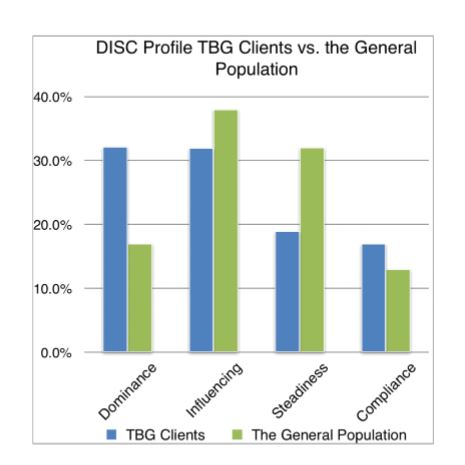
In a study of several hundred clients over the past year, we found some interesting perspectives. You probably have heard of the DISC profile (Dominance, Influencing, Steadiness, and Compliance).
The DISC profile is the instrument we use to help our clients understand the role of personality in career change.
People who exhibit more than 50% in their DISC scores are considered as “high” ratings, so a “High D,” for example, is a person whose dominance score is higher than 50%.
By a margin of 15% points, our clients do tend to be relatively High D versus the population at large. They are also relatively Low S (Steadiness). This makes good sense, because our clients are typically executives who are in a hurry to get results.
That’s why, for example, they see the advantage of the six-person team we assign each executive—we shorten their career change curve and allow them to focus on the truly value-adding aspects of their search.
High S by contrast are typically slow to change and therefore probably tend to stay in the same job longer than they should due to their personalities. This is conjecture, of course, but it seems reasonable and our data supports it.
People are not only High D or High S, of course, because everyone has secondary or even tertiary styles as well. High D and High I tend to be more extroverted, and we see a fairly strong correspondence in our client data that the High D’s have a tendency to also be High I and vice versa.
The High S and High C clients, however, do not show as much of a cross-correlation, though there is also a pocket of High C / High D clients, as well— people who are both detail-oriented and demanding.
We do not have the time or space here to go into the complete results of the study, but perhaps we should take a quick look at the relative short term priorities of our clients to see if these correlate in any way to personality.
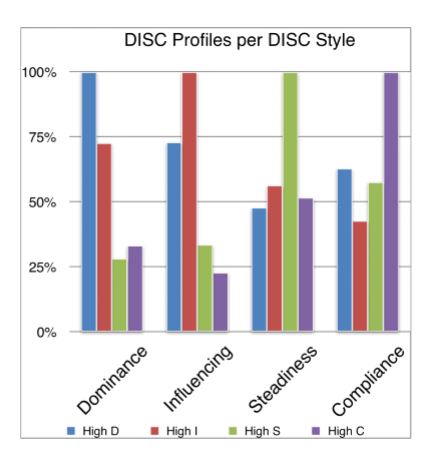
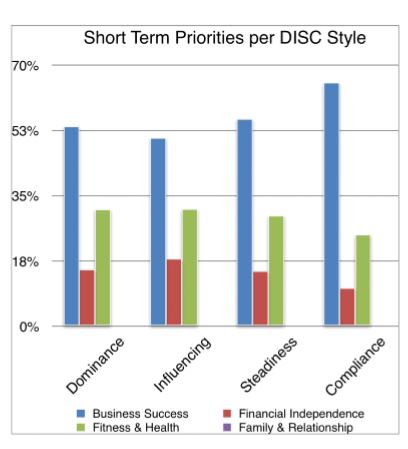
In the second stage of our Clarity Program© we look at four dimensions (Business Success, Financial Independence, Fitness & Health, and Family & Relationships) and ask each client to rate where they are and where they would like to be on each of those dimensions.
The chart at left shows firstly, that none of our clients rated Family & Relationships as the most important dimension. That is perhaps less surprising than you might think because our sample is heavily biased toward people focused on their careers.
Business Success is therefore logically the focus of all of our clients, followed by Fitness & Health, while Financial Independence rates a rather distant third on average. Interestingly it is exactly the detail-oriented and perhaps introverted High C (Compliance) type of client who places the highest priority on improving their Business Success.
And that is really not surprising because that is, in a nut shell, why people come to us in the first place.
If you are struggling to find that sweet spot where your life is balanced, prosperous, and exhilarating, maybe it’s time we talked about your career.
Peter Irish
CEO
The Barrett Group
Onward and Upward
Thousands of professionals come to us each year looking for better career opportunities. So many, in fact, that we can actually identify collections of symptoms of people who particularly benefit from our services. I think it’s helpful for executives to see themselves in these “personas” and thereby perhaps better understand the process that will quickly lead to a successful conclusion. Onward and upward.
One reason for this success is that we look at the whole person when clarifying career objectives—not just the targeted title, compensation, and geography. Whether they are executives, lawyers, people transitioning out of the military, or other professionals seeking support—our Clarity Program© uniquely facilitates this process.
But let’s take a specific example.
How about Adam? Over the course of Adam’s professional life, he has actually used services like the Barrett Group’s five times—four times successfully—an 80% success rate with a payback of more than 2,000%.

Each time he was up against some perceived or real constraint and needed to move to earn more money or become more international or travel less…
His first encounter was with a company in that introduced him to the power of self-knowledge via the Myers-Briggs Type Indicator, equipped him with a targeted and professional resume, and provided him with a mailing list. Within a few months, he increased his salary by 120% and became a Director at an international association.
The next time he wanted to move because he had suddenly received a new and particularly unsympathetic boss. Through another career management firm he obtained a list of 1,400 executives in the target geographies, sharpened up his resume, approached the so-called “unpublished market” (where 75% of Barrett Group clients land) and soon joined a Fortune 100 company as a regional General Manager intent on business development.
After four years he was again facing a ceiling and felt he had to move, so he sat down with yet another firm who expected to help him using only the recruiter market (only about 10% of our clients land through recruiters) and, unfortunately, this time the magic did not work. However, through perseverance and hard work, he did ultimately obtain a Vice President job at a multi-continental enterprise in the FMCG industry.
Eleven years later, Adam turned to a fourth firm who again helped his self-knowledge, packaged him appropriately for his targets, and then mailed his executive package to several hundred enterprises.
One of them ultimately hired him, and his return on investment in this case was about 25 to 1.
Lastly, several years later, Adam came to the Barrett Group. By this time, he was a bit weary of working for large corporations, so we helped him consider alternatives. Through our Clarity Program©, he realized that he actually did not want a job at all. Instead, he wanted to be his own boss and run a business. We helped him design an approach to choosing a business. He vetted several, and finally bought one and made a success of it. Today he is a satisfied and successful entrepreneur, and would certainly agree with this testimonial from his fellow Barrett Group client, Richard Bellas:
“I was very skeptical at first but decided to call the Barrett folks anyway. After working 22 years at PepsiCo in various senior management positions I was looking at new opportunities and/or senior executive/corporate roles. Another Ex-PEP executive spoke very highly about the group and their capabilities. That was almost two years ago, and it ended up being a great decision to call and they helped me with my professional choices and offered some helpful personal counsel, too.”

Every year we help hundreds of executives articulate their dreams and realize them. Are you satisfied where you are or are you ready to move onward and upward?
Peter Irish
CEO
The Barrett Group
Discover the New You
It is our pleasure to speak with hundreds of prospective career changers every month through which we gain a direct understanding of what is going on in the market place. These calls run the emotional gamut from desperate to philosophical, depending on the candidate’s situation. Through this blog I want to share some of these stories to help you understand that you as a would-be career changer are not alone. Many people share your concerns and challenges, and may be able to offer solutions. Discover the new you.
Whether they are executives, lawyers, people transitioning out of the military, or other professionals seeking support, our Clarity Program© uniquely facilitates this process, because we look at the whole person, not just the targeted title, compensation, and geography.
Let me tell you about Alex, who recently went through our Clarity Program©.

Alex has a successful career in business development for a data center SAAS company that requires a fair amount of travel and glad-handing. He has been through a divorce, has two children now more or less out on their own, and he thinks a lot about the future.
When he came to us he was unsure about his career direction. At 55, he was certainly afraid of ageism and that his career had plateaued, however, what he got through our Clarity Program© was a completely new understanding of what makes him tick and where he is going in life.
During the psychographic profile debrief, for example, he realized that he is a profound extrovert. He gains energy from interacting with people. He also realized that he needs support from others who are more attentive to details or better at following procedures. This might sound trivial, but for Alex it was a life-changing set of insights. He embraced this better understanding of his own persona wholeheartedly and was suddenly happier and more fulfilled.
We went on from there to explore his current constraints and discovered that these were largely in the Financial Independence and Business Success areas. We picked these apart and identified short term measures he could adopt to improve on both of these key challenges.
Lastly, we worked on his personal strategic plan. We usually start with the Vision five years out, in other words, “where is this journey going?”, and once that Vision is fully rounded and clear, we then work backwards from there to see what the career changer needs to accomplish to realize the Vision.
In Alex’s case, he had a really big Vision to become a C-Level executive based in Switzerland earning $500,000 per year with a distributed world-wide team, etc.
Alex did a good job of rounding out his Vision to the social and personal side as well. We both felt surprisingly comfortable with his audacious target.
We realized many sub-steps along the way, for example, that Alex needs to actually spend time with C-Level executives if he ever hopes to be accepted as one. More specifically, he does not now have the financial management experience to succeed at that strategic level, so we concluded that he would need to get a “stepping-stone” job first to help him gain key skills and thus qualify for the big job he envisions.
All in all, Alex came out of the whole exercise energized and excited. He’s pursuing information interviews with executives who can help him build his network and, well, in his own words…
“Had I known ahead of time how powerful this is, I would have been jumping all over it much earlier. What I think might benefit you when you speak with potential clients who, like I, don’t know what they don’t know, is to offer to speak firsthand with someone who went through it.
I volunteer to be one you can call upon to be a ‘live’ reference.
Thank you for helping tremendously in changing my life!”

That’s the hidden benefit of being in the career management field: the warm appreciation we get when our clients succeed. Fortunately, we at the Barrett Group get a lot of this feedback, for which we are very grateful.
Peter Irish
CEO
The Barrett Group
